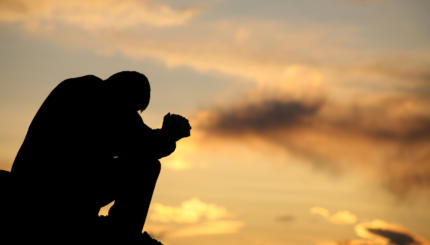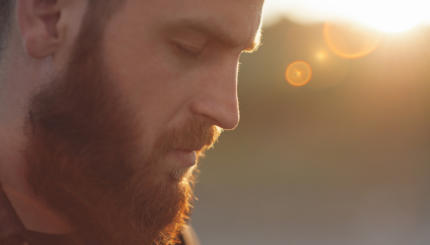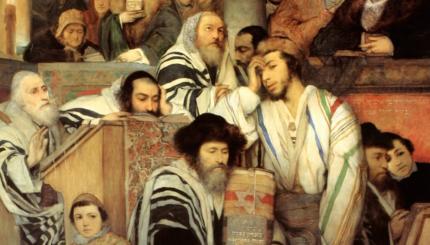Kabbalistic authors drew connections between prayer (and the fulfillment of other commandments as well) and the 10 sefirot, which are personal aspects of the one hidden God. These are often represented pictorially by a diagram resembling a human body, with the highest sefirah, Eyn Sof ("Infinite"), at the head. Reprinted with permission from The Mystic Quest: An Introduction to Jewish Mysticism, published by Jason Aronson Inc.
In prayer, the mystics differed from conventionally observant Jews in several important ways. They believed that the traditional liturgy of daily, Sabbath, and festival prayers contain hidden mystical meanings and references to dynamic processes within the sefirot. The mystical interpretation of the prayer Shema Yisrael as an evocative and theurgic wedding ceremony between Tiferet and Malkhut [the sefirot of "Beauty" and "Sovereignty"] is a classic illustration of this approach.
The mystics also believed that the words of the prayers themselves take on a life of their own. The words of prayer, once uttered, become entities unto themselves and ascend upward to the sefirot with which they unite and [which they] manipulate:
"All that which man thinks and every meditation of his heart is ineffective until his lips utter them out loud…. That very word which he utters splits the air, going, rising and flying through the world, until it becomes a voice. That voice is born by the winged creatures who raise it up to the King, who then hears it" ( III:294a-b).

Help us keep Jewish knowledge accessible to millions of people around the world.
Your donation to My Jewish Learning fuels endless journeys of Jewish discovery. With your help, My Jewish Learning can continue to provide nonstop opportunities for learning, connection and growth.
Mystics and Minyan
Daily prayer is understood to bring about the perfection (tikkun) of the Shekhinah [God’s presence or in-dwelling]. According to rabbinic law certain prayers can only be said when a prayer quorum [minyan] is assembled. The minimum number that defines a congregation is set at 10 adult males (Babylonian Berakhot 21b [as traditionally interpreted]). This is based upon Moses’ designation of the 10 scouts who explored the land of Israel at his command as a congregation (edah, Numbers 14:27). Rabbinic legend maintains that the Shekhinah dwells in the midst of a congregation of 10 men who pray together (Babylonian Talmud Berakhot 6a). In the same source God is depicted as being angry when he comes to a congregation and does not find a prayer quorum.
The rabbinic prayer quorum (minyan) is a precondition for the creation of a "perfection" among the sefirot. The prayer quorum of 10 reflects and invokes the assembly of the 10 sefirot. Just as there are 10 sefirot, there ought to be a quorum of 10 men assembled for each regularly scheduled prayer service:
"How precious is Israel in the sight of the Holy One, Blessed is He! In every place they dwell, the Holy One, Blessed is He, is found among them because He never takes His love from them…. Blessed is the man who is among the first 10 to arrive at the synagogue. Among them is completed that which ought to be completed [i.e., the quorum and the reenactment of joining the 10 sefirot together]. These are sanctified by the Shekhinah before any others, as has been explained. Ten should arrive at the synagogue simultaneously rather than separately so as not to delay the completion of the limbs [of the ten sefirot] just as man was created by God all at once and all his limbs were perfected together" (Zohar III:126a).
Mysticism and Synagogue
The notion that there is a correspondence between human religious actions and divine processes is axiomatic in Jewish mysticism. This is evident in the mystical approach to the synagogue itself. The earliest synagogues were established during the Babylonian Exile following the destruction of the first Temple in Jerusalem in 586 B.C.E. Later, synagogues, called the minor sanctuary in rabbinic parlance (mikdash me’at), replaced the Temple, and formal prayers replaced Temple sacrifices as the authorized form of worship (Babylonian Talmud Berakhot 26a).
In mystical symbolism the destroyed Temple still exists within [the sefirah of] Malkhut as the divine prototype of the earthly Temple. The synagogue, therefore, corresponds to Malkhut:
"It is commanded to build a sanctuary below corresponding to the [heavenly] sanctuary above…. One should build a synagogue and should pray within it daily and worship the Holy One, Blessed be He, for prayer is called worship (Sifrei Deuteronomy 41). The synagogue should be constructed with great beauty and adorned with all manner of refinements because the synagogue below corresponds to the heavenly synagogue." (Zohar II:59b)
Because of the correspondence between the earthly synagogue and Malkhut, the Zohar [collection of mystical commentary] prefers conventional prayer said in a synagogue to prayer offered anywhere else. In fact, the Zohar introduced into the body of Jewish customs several new practices and rites based on mystical principles.
For example, the preference for synagogue prayer over prayers said elsewhere is based on the idea that since the Shekhinah can only be reached by a very narrow path, earthly prayers must be concentrated into a narrow channel to ascend. The very structure of a synagogue is preferable to an open field because the former would concentrate whereas the latter would diffuse the ascending channel of prayer.
The Zohar also introduces as law the notion that a synagogue must have windows so that the prayers can exit the synagogue and ascend through the narrow passage of the window (Zohar II:59b-60a).
The Zohar also states that congregational prayer is preferable to individual prayer because God scrutinizes critically the worthiness and actions of an individual who prays alone. His prayer can ascend only as far as his actions warrant. Congregational prayer, however, ascends easily because of the aggregate merit of those assembled (Zohar I:234; Yissakhar Baer of Prague, Sefer Yesh Sakhar [Warsaw, 1901], 13a). If, however, one cannot pray with a congregation, he should at least pray at the same time as the congregation.


